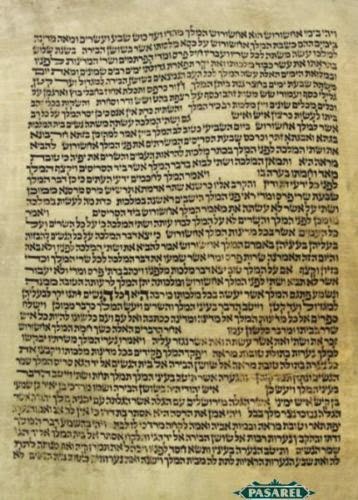Megillah - New Innovations
Here you have another new innovation in this Megillah which is not part of our Massoretic tradition. The fact that the Shem HaShem doesn't appear in the Megillah doesn't deter this scribe from highlighting any allusions.
In this case the sofer has highlighted the "Rashei Tevot" H-V-H-Y in order to bring to mind that HaShem is "hidden" and working in the background. The fact that the letters are in reverse order is most important, for one can only be cognizant of the YAD HASHEM when looking "backwards" and examining all of the events after they have taken place.
In a similar way, we have also done the same by adopting the modern convention of initiating many of our columns with the word HaMELECH. This is our way of bringing out the same concept that, in the story of the Megillah, HaShem is hidden and working in the background. Therefore, we interpret that whenever HaMELECH is written by itself - this refers to HASHEM; but, when haMelech Achashverosh is written - this refers to a king of flesh and blood.


Shalom R. Alberto - not that new an innovation. This roshey teyvot idea on Hashem's name in four places in the megillah has been around for at least a couple of centuries and I've seen it on a few old Megillot. R. Baer references them as a tradition in his tikkun in the footnotes. I've also seen them marked with special taggin - one was very nicely done with taggin shaped like rimmonim However it is not part of the massorah as you say and generally frowned upon because there is no real reason for making them rabati but identifying them in some way is a nice idea. In terms of the hamelech tradition for Ashkenazim, R. Reuben Mendelovitz explains that the Kol Ya’akov written in 1852 explains that the scribes of Bagdad were accustomed to write Hamelech Megillot and that there are no sources earlier than that.
ReplyDeleteHi R. Mordechai,
ReplyDeleteThese are all beautiful innovations that are superadded to our basic Massora. To me the fact they exist is a demonstration of the love and attachment that we have with regards to it. These find themselves expressed in many different ways within the bounds of Halakha.
In my humble opinion this is a testimony that our tradition is rich and very much alive. All of these innovations must be seen as part of Ze Eli VeAnvehu. They are a unique testimony to that love and special meaning that we attach to our written tradition. I would love to see a picture of the taggin shaped like rimmonim.
There is a difference between starting a column with Hamelech and creating new large letters without Mesora...
ReplyDeleteAccording to your reasoning, we should start again doing otiot meshunot in Sifrei Torah but the fact is that we don't. I think when it comes to this, Ze Keili refers to the beauty of the Ktav, but not in the aestetical innovations. Our Sifrei Torah of today are not less nice even tough they lack the otiot meshunot; they are in fact usually more beautiful since the klaf is often uniform, the lines are completely symmetrical and we have a tikkun that guarantees perfect alignment in the whole scroll.
I should also add that many (eliahu raba, mellitus shomayim, orchids chayim) disagree with adding crowns and general drawings in the Megilla - even tough you would think this adds Ze Keili Veanveihu.
ReplyDeleteAlso brought in Ot Yatziv that the Zanz rebbe was against it, saying "is it also showing how the sons of haman were hanged? Is the megilla supposed to be a book of drawings and pictures"
The point being - Ze Keili Veanveihu is not necessarily adding aestethical motifs. It most probably refers to a nice klaf and ktav.
Doesn't Keset say "mochin b'yadam" or a similar lashon about writing the Shem Hashem through that sort of acronym? I restored a megillah that did it, and left the large letters as they were, but I would never write them lechatchilah.
ReplyDelete